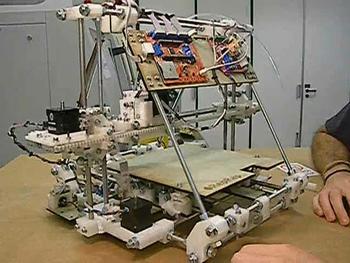NASA is investing in a firm which is tasked with developing a 3D printer capable of printing pizzas on the International Space Station. The Texas-based Systems & Materials Research Cooperation (SMRC) has won the NASA contract and will design, test, and build the food printer using knowledge and experience it has gained making a chocolate printer.
UniverseToday (UT) magazine informs us that SMRC will begin construction of the ‘replicator’ food printing prototype two weeks from now. The device will be specifically aimed at creating pizzas which the 3D printer will build up “by first layering out the dough onto a heated plate then adding tomato sauce and toppings”. Apparently the astronauts have been missing pizzas from their menus for years.
The new space-bound food replicator will be based upon an open source (or open sauce?) 3D printer called the RepRap, pictured above. However the Pizza ingredients and toppings chosen for the “cartridge injectors” don’t sound very appetising. UT reports that the pizza will be constructed by squirts of organic base powders “derived from algae, insects and grass” mixed with water. The NASA pizza doesn’t sound like it will take off in popularity in the same way that the Four Seasons, Hawaiian or even Sloppy Guiseppe has.
An important consideration for long missions in space is the shelf life of the food. SMRC intend to make the printed pizzas from “30-year shelf stable foodstuffs”. In its proposal to NASA the firm wrote “The 3-D printing system will provide hot and quick food in addition to personalized nutrition, flavor and taste. The biggest advantage of 3-D printed food technology will be zero waste, which is essential in long-distance space missions”.
The machines developed by SMRC may also be useful to the military; “A 3D-printed food system can reduce military logistics, disposal waste, increase operational efficiency and mission effectiveness especially during wartime”. Also commercially, the machine may be marketed to “weight loss and weight gain” target markets.
One day we might even have a voice-activated space Goblin Teasmade.
Meanwhile the International Space Station’s first non-food 3D printer is due for delivery in 2014. This will be of great utility to the astronauts in being able to produce tools and parts on-site, without having to nip down to the shops.







